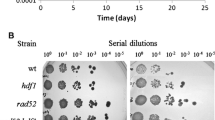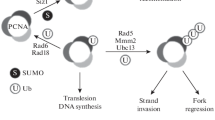Abstract
DNA repair, checkpoint pathways and protection mechanisms against different types of perturbations are critical factors for the prevention of genomic instability. The aim of the present work was to analyze the roles of RAD17 and HDF1 gene products during the late stationary phase, in haploid and diploid yeast cells upon gamma irradiation. The checkpoint protein, Rad17, is a component of a PCNA-like complex—the Rad17/Mec3/Ddc1 clamp—acting as a damage sensor; this protein is also involved in double-strand break (DBS) repair in cycling cells. The HDF1 gene product is a key component of the non-homologous end-joining pathway (NHEJ). Diploid and haploid rad17Δ/rad17Δ, and hdf1Δ Saccharomyces cerevisiae mutant strains and corresponding isogenic wild types were used in the present study. Yeast cells were grown in standard liquid nutrient medium, and maintained at 30°C for 21 days in the stationary phase, without added nutrients. Cell samples were irradiated with 60Co γ rays at 5 Gy/s, 50 Gy ≤ Dabs ≤ 200 Gy. Thereafter, cells were incubated in PBS (liquid holding: LH, 0 ≤ t ≤ 24 h). DNA chromosomal analysis (by pulsed-field electrophoresis), and surviving fractions were determined as a function of absorbed doses, either immediately after irradiation or after LH. Our results demonstrated that the proteins Rad17, as well as Hdf1, play essential roles in DBS repair and survival after gamma irradiation in the late stationary phase and upon nutrient stress (LH after irradiation). In haploid cells, the main pathway is NHEJ. In the diploid state, the induction of LH recovery requires the function of Rad17. Results are compatible with the action of a network of DBS repair pathways expressed upon different ploidies, and different magnitudes of DNA damage.







Similar content being viewed by others
References
Hartwell, L., Weinert, T.A.: Checkpoints: controls that ensure the order of cell cycle events. Science 246, 629–634 (1989). doi:10.1126/science.2683079
Elledge, S.J.: Cell cycle checkpoints: preventing an identity crisis. Science 274, 1664–1672 (1996). doi:10.1126/science.274.5293.1664
Nyberg, K.A., Michelson, R.J., Putnam, C.W., Weinert, T.A.: Toward maintaining the genome: DNA damage and replication checkpoints. Annu. Rev. Genet. 36, 617–656 (2002). doi:10.1146/annurev.genet.36.060402.113540
Zhang, H., Zhu, Z., Vidanes, G., Mbangkollo, D., Liu, Y., Siede, W.: Characterization of DNA damage-stimulated self-interaction of Saccharomyces cerevisiae checkpoint protein Rad17p. J. Biol. Chem. 276, 26715–16723 (2001). doi:10.1074/jbc.M103682200
Majka, J., Burgers, P.M.: Yeast Rad17/Mec3/Ddc1: a sliding clamp for the DNA damage checkpoint. Proc. Natl. Acad. Sci. U.S.A. 100, 2249–2254 (2003). doi:10.1073/pnas.0437148100
Friedberg, E.C., Walker, G.C., Siede, W., Schutz, R.A., Ellenberger, T.: In: DNA repair and mutagenesis, 2nd edn, pp. 711–717. ASM, Washington (2006)
Siede, W., Friedl, A.A., Dianova, I., Eckardt-Schupp, F., Friedberg, E.C.: The Saccharomyces cerevisiae Ku autoantigen homologue affects radiosensitivity only in the absence of homologous recombination. Genetics 142, 91–102 (1996)
Werner-Washburne, M., Braun, E., Johnston, G.C., Singer, R.A.: Stationary phase in the Saccharomyces cerevisiae. Microbiol. Rev. 57, 383–401 (1993)
Bracesco, N., Candreva, E.C., Keszenman, D., Sánchez, A.G., Soria, S., Dell, M., Siede, W., Nunes, E.: Roles of Saccharomyces cerevisiae RAD17 and CHK1 checkpoint genes in the repair of double strain breaks in cycling cells. Radiat. Environ. Biophys. 46, 401–407 (2007). doi:10.1007/s00411-007-0119-y
Friedl, A., Kiechle, M., Fellerhoff, B., Eckardt-Schupp, F.: Radiation-induced chromosome aberrations in S. cerevisiae: influence of DNA repair pathways. Genetics 148, 975–988 (1998)
Nunes, E., Bracesco, N., Candreva, E., Keszenman, D., Salvo, V., Siede, W.: Checkpoint determinant and DNA repair: dual function of the RAD17 gene of S. cerevisiae. In: Abstracts of the XIV International Biophysics Congress, IUPAB, Buenos Aires, p. 43 (2002)
Geigl, E.M., Eckardt-Schupp, F.: The repair of double-strand breaks and S1 nuclease-sensitive sites can be monitored chromosome-specifically in Saccharomyces cerevisiae using pulsed-field gel electrophoresis. Mol. Microbiol. 5, 1615–1620 (1991). doi:10.1111/j.1365-2958.1991.tb01908.x
Keszenman, D., Candreva, E., Nunes, E.: Cellular and molecular effects of bleomycin are modulated by heat shock in Saccharomyces cerevisiae. Mutat. Res. 459, 29–41 (2000)
Friedberg, E.C., Walker, G.C., Siede, W., Schutz, R.A., Ellenberger, T.: In: DNA repair and mutagenesis, 2nd edn, p. 666. ASM, Washington (2006)
Baur, M.: Analyse der Rolle von Glutathion bei der Induktion und Reparatur von Doppelstrangbrueche mit Hilfe der Puls-Feld-Gelelektrophorese in Hefe. Dissertation, Ph.D. Thesis, Biology Faculty, L-Maximilians University, Munich, Germany (1990)
Keszenman, D.J., Candreva, E.C., Sánchez, A.G., Nunes, E.: RAD6 gene is involved in heat shock induction of bleomycin resistance in Saccharomyces cerevisiae. Environ. Mol. Mutagen. 45, 36–43 (2005). doi:10.1002/em.20083
Sánchez, Y., Desany, B.A., Jones, W.J., Liu, Q., Wang, B., Elledge, S.J.: Regulation of RAD53 by the ATM-like kinases MEC1 and TEL1 in yeast cell cycle checkpoint pathways. Science 271, 357–360 (1996). doi:10.1126/science.271.5247.357
Lowndes, N.F., Murguia, J.R.: Sensing and responding to DNA damage. Curr. Opin. Genet. Dev. 10, 17–25 (2000). doi:10.1016/S0959-437X(99)00050-7
Bashkirov, V., King, J., Bashkirova, E., Schmuckli-Maurer, J., Heyer, W.: DNA repair protein Rad55 is a terminal substrate of the DNA damage checkpoints. Mol. Cell. Biol. 20, 4393–4404 (2000). doi:10.1128/MCB.20.12.4393-4404.2000
Lewis, L.K., Resnik, M.A.: Tying up loose ends: nonhomologous end-joining in Sacharomyces cerevisiae. Mutat. Res. 451, 71–89 (2000). doi:10.1016/S0027-5107(00)00041-5
Palmbos, P.L., Daley, J.M., Wilson, T.E.: Mutations of the Yku80 C terminus and Xrs2 FHA domain specifically block yeast nonhomologous end joining. Mol. Cell. Biol. 25, 10782–10790 (2005). doi:10.1128/MCB.25.24.10782-10790.2005
De la Torre-Ruiz, M.A., Lowndes, N.A.: The Saccharomyces cerevisiae DNA damage checkpoint is required for efficient repair of double strand breaks by non-homologous end joining. FEBS Lett. 467, 311–315 (2000). doi:10.1016/S0014-5793(00)01180-7
Soutoglou, E., Misteli T.: Activation of the cellular DNA damage response in the absence of DNA lesions. Science 320, 1507–1510 (2008). doi:10.1126/science.1159051
Acknowledgements
We are grateful to Lourdes Blanc for expert technical assistance. This work was supported in part by PEDECIBA and Universidad de la República, Uruguay.
Author information
Authors and Affiliations
Corresponding author
Rights and permissions
About this article
Cite this article
Nunes, E., Candreva, E., Bracesco, N. et al. HDF1 and RAD17 Genes are Involved in DNA Double-strand Break Repair in Stationary Phase Saccharomyces cerevisiae . J Biol Phys 34, 63–71 (2008). https://doi.org/10.1007/s10867-008-9105-0
Received:
Accepted:
Published:
Issue Date:
DOI: https://doi.org/10.1007/s10867-008-9105-0




